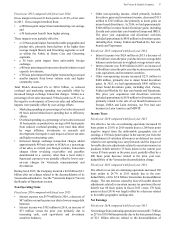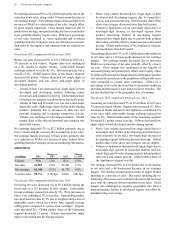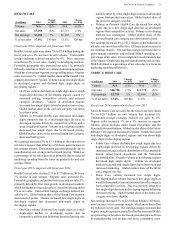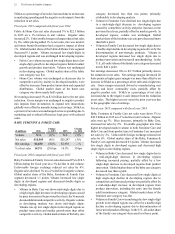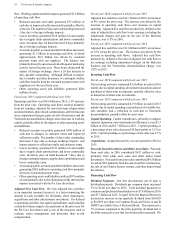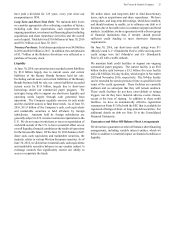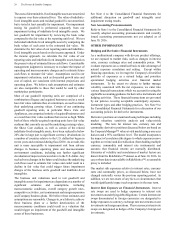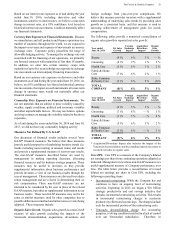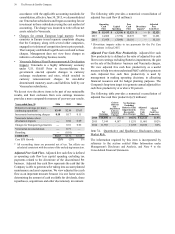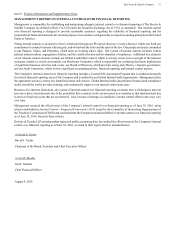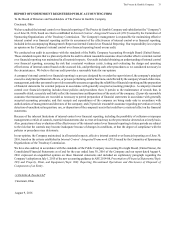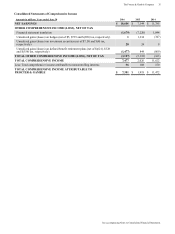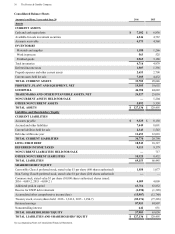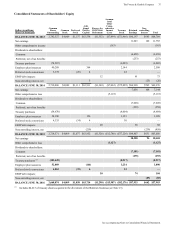Proctor and Gamble 2016 Annual Report Download - page 41
Download and view the complete annual report
Please find page 41 of the 2016 Proctor and Gamble annual report below. You can navigate through the pages in the report by either clicking on the pages listed below, or by using the keyword search tool below to find specific information within the annual report.The Procter & Gamble Company 27
for our various cross-border transactions. We obtain advance
rulings with tax authorities to support our positions, where
possible, to help manage these exposures. Nonetheless, many
of the underlying transactions are subject to audit, resulting in
uncertainty until the ultimate audit resolution. We evaluate our
tax positions and establish liabilities in accordance with the
applicable accounting guidance on uncertainty in income
taxes. We review these tax uncertainties in light of changing
facts and circumstances, such as the progress of tax audits, and
adjust them accordingly. We have a number of audits in process
in various jurisdictions. Although the resolution of these tax
positions is uncertain, based on currently available
information, we believe that the ultimate outcomes will not
have a material adverse effect on our financial position, results
of operations or cash flows.
Because there are a number of estimates and assumptions
inherent in calculating the various components of our tax
provision, certain changes or future events such as changes in
tax legislation, geographic mix of earnings, completion of tax
audits or earnings repatriation plans could have an impact on
those estimates and our effective tax rate. For additional details
on the Company's income taxes, see Note 5 to the Consolidated
Financial Statements.
Employee Benefits
We sponsor various post-employment benefits throughout the
world. These include pension plans, both defined contribution
plans and defined benefit plans, and other post-employment
benefit (OPEB) plans, consisting primarily of health care and
life insurance for retirees. For accounting purposes, the defined
benefit pension and OPEB plans require assumptions to
estimate the projected and accumulated benefit obligations,
including the following variables: discount rate; expected
salary increases; certain employee-related factors, such as
turnover, retirement age and mortality; expected return on
assets; and health care cost trend rates. These and other
assumptions affect the annual expense and obligations
recognized for the underlying plans. Our assumptions reflect
our historical experiences and management's best judgment
regarding future expectations. As permitted by U.S. GAAP,
the net amount by which actual results differ from our
assumptions is deferred. If this net deferred amount exceeds
10% of the greater of plan assets or liabilities, a portion of the
deferred amount is included in expense for the following year.
The cost or benefit of plan changes, such as increasing or
decreasing benefits for prior employee service (prior service
cost), is deferred and included in expense on a straight-line
basis over the average remaining service period of the
employees expected to receive benefits.
The expected return on plan assets assumption impacts our
defined benefit expense, since many of our defined benefit
pension plans and our primary OPEB plan are partially funded.
The process for setting the expected rates of return is described
in Note 8 to the Consolidated Financial Statements. For 2016,
the average return on assets assumptions for pension plan assets
and OPEB assets was 7.2% and 8.3%, respectively. A change
in the rate of return of 100 basis points for both pension and
OPEB assets would impact annual after-tax benefit expense by
approximately $100 million.
Since pension and OPEB liabilities are measured on a
discounted basis, the discount rate impacts our plan obligations
and expenses. Discount rates used for our U.S. defined benefit
pension and OPEB plans are based on a yield curve constructed
from a portfolio of high quality bonds for which the timing and
amount of cash outflows approximate the estimated payouts
of the plan. For our international plans, the discount rates are
set by benchmarking against investment grade corporate bonds
rated AA or better. The average discount rate on the defined
benefit pension plans and OPEB plans of 2.1% and 3.6%,
respectively, represents a weighted average of local rates in
countries where such plans exist. A 100 basis point change in
the pension discount rate would impact annual after-tax defined
benefit pension expense by approximately $200 million. A
change in the OPEB discount rate of 100 basis points would
impact annual after-tax OPEB expense by approximately $86
million. For additional details on our defined benefit pension
and OPEB plans, see Note 8 to the Consolidated Financial
Statements.
Goodwill and Intangible Assets
Significant judgment is required to estimate the fair value of
intangible assets and in assigning their respective useful lives.
Accordingly, we typically obtain the assistance of third-party
valuation specialists for significant tangible and intangible
assets. The fair value estimates are based on available
historical information and on future expectations and
assumptions deemed reasonable by management, but are
inherently uncertain.
We typically use an income method to estimate the fair value
of intangible assets, which is based on forecasts of the expected
future cash flows attributable to the respective assets.
Significant estimates and assumptions inherent in the
valuations reflect a consideration of other marketplace
participants, and include the amount and timing of future cash
flows (including expected growth rates and profitability), the
underlying product or technology life cycles, economic
barriers to entry, a brand's relative market position and the
discount rate applied to the cash flows. Unanticipated market
or macroeconomic events and circumstances may occur, which
could affect the accuracy or validity of the estimates and
assumptions.
Determining the useful life of an intangible asset also requires
judgment. Certain brand intangible assets are expected to have
indefinite lives based on their history and our plans to continue
to support and build the acquired brands. Other acquired
intangible assets (e.g., certain trademarks or brands, customer
relationships, patents and technologies) are expected to have
determinable useful lives. Our assessment as to brands that
have an indefinite life and those that have a determinable life
is based on a number of factors including competitive
environment, market share, brand history, underlying product
life cycles, operating plans and the macroeconomic
environment of the countries in which the brands are sold. Our
estimates of the useful lives of determinable-lived intangible
assets are primarily based on these same factors. All of our
acquired technology and customer-related intangible assets are
expected to have determinable useful lives.


